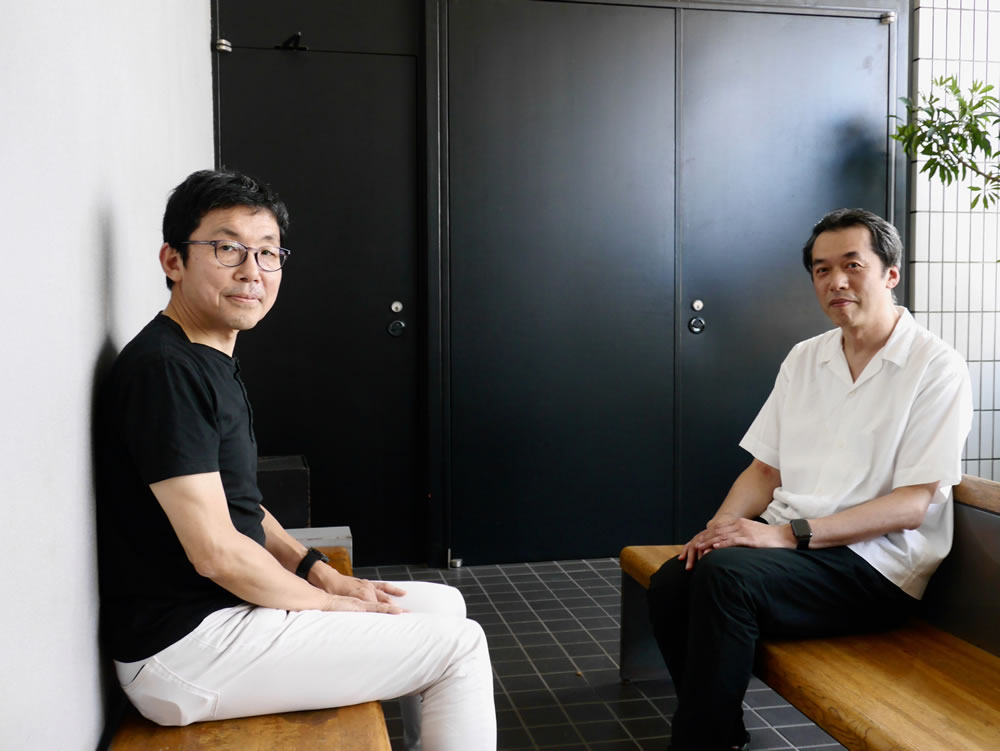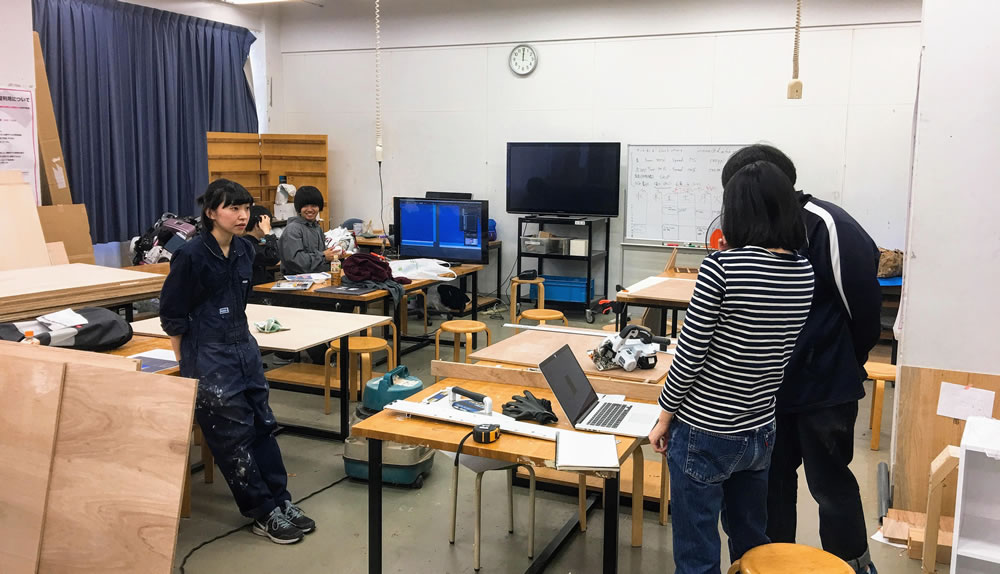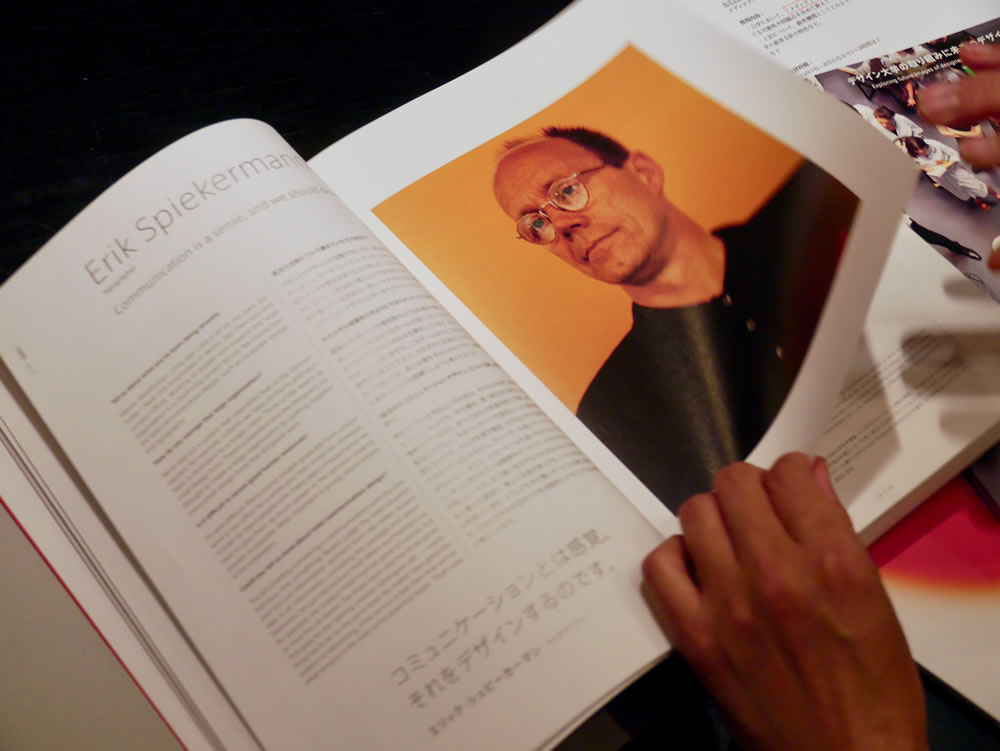This is a series of face-to-face talks by university teachers on schools to learn media art. The file1. will spotlight Tama Art University, which is the first art university in Japan that set up a department specializing in information design. About 120 students are admitted in each academic year to the university’s Department of Information Design and enrolled either in the Art and Media Course or the Interaction Design Course from the beginning. Roughly speaking, the former specializes in art, whereas the latter specializes in design. Yet their curriculums and graduates’ career paths do not necessarily follow this classification. Two teachers at the department talked about its reality and history.
 Akihiro Kubota (left) with Mitsuhiro Miyazaki
Akihiro Kubota (left) with Mitsuhiro Miyazaki
Interdisciplinary field of art and design
Tama Art University (hereafter, referred to as TAU) opened the Department of Information Design in 1998, pioneering in the field of information design. Prof. Kubota and Prof. Miyazaki teach full time at the Art and Media Course and the Interaction Design Course, respectively. When did you start to be involved in the Department of Information Design?
Akihiro Kubota (hereafter Kubota): I moved to TAU with the start of the Department of Information Design in 1998, so this is my 21st year at the department. Before that, I was with the Research into Artifacts, Center for Engineering of The University of Tokyo. When the department started up, we faced the challenge of incorporating digital media into the art education. It wasn’t that an engineer would apply digital media to art, but that digital media and computer networks should be substantially introduced into the art education or the design education. Now, 20 years later, the meaning of the phrase “digital media” has greatly changed both technologically and socially.
Mitsuhiro Miyazaki (hereafter Miyazaki):I became a full-time teacher on the eighth year of the Department of Information Design. Before that, I’d been a parttime lecturer at the Faculty of Art and Communication of TAU for more than a decade, while working for Axis Inc. to engage in art direction for design magazines and websites as my main line of business. Axis had introduced the technique of designing by computer, pioneering in the industry. Today, desk top publishing (DTP) is nothing unusual, but very few businesses used it around that time. I was asked to teach the technique at the Faculty of Art and Communication and started teaching it. More than a decade later, I became a full-time teacher at the Interaction Design Course. I’ve taught interface design and interaction design at the course. Since 2016, I’ve been in charge of a subject named “Social Design Field.” My students make efforts to find out, on the basis of design and technology, what they can do for social problems. To tell you the truth, when I was offered by Prof. Kubota to join this talk, I found myself asking him, “The topic is media art. Do you really think I’m qualified?”
 A lesson at the Art and Media Course of the Department of Information Design. Part-time lecturer Takahiro Yamaguchi, second from left, with full-time lecturer Akihiko Taniguchi, third from left
A lesson at the Art and Media Course of the Department of Information Design. Part-time lecturer Takahiro Yamaguchi, second from left, with full-time lecturer Akihiko Taniguchi, third from left
Kubota: Media art isn’t identical to technology art. I assume media is an environment, so I believe problems of human or society should be more focused on than technology. Based on this belief, I selected Mr. Miyazaki.
Miyazaki: In view of this, it’s very unique that the Art and Media Course and the Interaction Design Course exist in the same department at TAU.
Kubota: A single department having art and design courses can serve for interdisciplinary studies. This department can connect engineering, art, design and other fields with each other. It’s very similar to the move of entire society. Looking back on the past 20 years, I’ve been seeking how to run our curriculum side by side with the times.
 A live coding workshop in 2018 with leading live coding artist Alex McLean as a guest teacher
A live coding workshop in 2018 with leading live coding artist Alex McLean as a guest teacher
 Students in a workshop in 2018
Students in a workshop in 2018
Importance of doing non-quantifiable research
More than 20 years have passed since the Department of Information Design was established. What major changes do you feel have happened at the front lines of education?
Kubota: Today, the society has been so diversified, and we are required to create designs by taking into account what we cannot experience by ourselves. In view of this, I’d say conducting research has been becoming more and more important over the past 20 years or so. Up until now, the curriculum and the lessons have been organized so that they put emphasis on using hands and making things. Here, I’ve recognized once again conducting research is so important for designing. Conducting research is similarly important in the field of art. It’s essential to have some doubts about what we see and feel, and be able to do critical thinking toward ourselves.
Miyazaki: In the field of design, quantitative marketing research is often used to know the needs of consumers. In contrast, in recent years, it’s becoming more and more important to conduct qualitative research to collect data that cannot be measured numerically and to carefully observe consumer behavior. These methods have been incorporated in the design education at university.
 An inside image of the book titled AXIS THE COVER STORIES—Interviews with 115 designers published by Axis Inc. in 2018. This book features cover interviews that have been published in the design magazine AXIS under Mitsuhiro Miyazaki’s art direction.
An inside image of the book titled AXIS THE COVER STORIES—Interviews with 115 designers published by Axis Inc. in 2018. This book features cover interviews that have been published in the design magazine AXIS under Mitsuhiro Miyazaki’s art direction.
Kubota: Art has been a typical non-quantifiable field from the beginning. It may have something to do with its distinctive business culture. As a philosophy of university, we should not lose an approach to avoiding determining something by a single sense of value and placing importance on minorities. Related to conducting research, I feel cultural anthropology is becoming particularly important in recent years. Our course at TAU has Prof. Chihiro Minato, who specializes in fieldwork and photographing and promotes visual anthropology, and I often talk with him. In the 1990s, the importance of prototyping (writer’s note: a method in the engineering field for developing products through repeating a process of producing models and examining them) was recognized in society, leading to build a limited community of consumers who use a certain product and evaluate it. Yet today, designers should take into account the whole society, not a small community of users. The Internet and the social media have been further spreading and society has been becoming fragile. Of course, it’s still necessary to follow the basic pattern of doing drawings and designs at first and then making models. But doing these things doesn’t account for even half of the entire design work.
Miyazaki: When we present our ideas or thoughts to a complex society, we often don’t know what will happen as a result. In contrast, in academic-industry joint projects, we can do this process experimentally in university to experience what will happen next. This is a great merit of such projects.
Kubota: For instance, I’ve worked on an academicindustry joint project with Nestle Japan Limited with Prof. Miyazaki and Prof. Yoshiharu Hamada of the Product Design Course of the Department of Product and Textile Design at TAU. In such an interdisciplinary, practical project, students conduct research that is quite different from the research they do to study and write articles. Doing these diversified experiments is possible at TAU and this is one of TAU’s characteristics as an art university.
 Students give a presentation to Nestle Japan Limited officials in 2016.
Students give a presentation to Nestle Japan Limited officials in 2016.
Learning how to question
Miyazaki: The three teachers involved in the project (Miyazaki, Kubota and Hamada) have different academic backgrounds, so we ourselves greatly enjoyed working for the project. I feel the students enjoyed watching how we worked. Since Prof. Hamada specializes in the field of product design, Prof. Kubota in the field of media art and I in the field of information design, our views on students’ works are naturally different. This enables students to learn to see things from various different perspectives, not just learn one correct answer. This may be an interesting element of art universities.
Kubota: Teachers tend to say “I ‘teach’ this and this” to students. It’s not just simply conveying knowledge or information. The Internet and libraries provide knowledge and students can learn techniques anywhere outside university, too. I want to put emphasis on conveying how to learn new things by showing them how we ourselves learn. I call joint projects with other TAU departments “On-Campus Faculty Development.” I’ve stressed to the university authorities that these projects serve as a place to learn for teachers, too. In fact, there’s no distinction between teachers and students in terms of learning. Teachers should show students superb ways of learning first of all.
What themes do you work on in academic-industry joint projects?
Miyazaki: Conventionally, designers’ ordinary work starts with receiving orders from clients, such as designing a product or designing an advertisement. In academic-industry joint projects, we do more than that. In a project with Nestle, for example, students start with finding problems to address, such as “what is a new experience with coffee like?” The field of design today has been shifting its emphasis to discovering problems from solving problems. I think it’s very important how we can discover and/or redefine problems. In this respect, the Interaction Design Course can learn a lot from the Art and Media Course because the field of art has a high level of expertise in posing questions and raising issues.
Kubota: In ordinary university education, teachers or laboratories have some specific themes and their members share work and cooperate with each other to attain their challenging goals. At art universities, in contrast, themes are always on the side of students. It’s not “giving goals to attain” to students but continuedly telling them to find “what you want to do” for a period of four years. As a place for education, art universities are tested on how their students come to be able to discover their own possibilities by themselves. If students say after their four years’ pursuit, “I’ve found I want to work on this,” they’ll eventually be able to do something independently at their own initiative, even if they themselves or society would somehow change later. This may be one of the ultimate goals of art universities.
 Books by Akihiro Kubota. The left, co-authored with Minoru Hatanaka, is titled Media Art Genron: Anata wa ittai nani o sagashi motomete irunoka? (Media art principles: What on earth are you looking for?) published by Film Art Inc. in 2018. The right book is titled Harukanaru tasha no tame no design: Kubota Akihiro no shisaku to jissou (Design for Otherness: Akihiro Kubota’s thinking and implementation) published by BNN, Inc. in 2017.
Books by Akihiro Kubota. The left, co-authored with Minoru Hatanaka, is titled Media Art Genron: Anata wa ittai nani o sagashi motomete irunoka? (Media art principles: What on earth are you looking for?) published by Film Art Inc. in 2018. The right book is titled Harukanaru tasha no tame no design: Kubota Akihiro no shisaku to jissou (Design for Otherness: Akihiro Kubota’s thinking and implementation) published by BNN, Inc. in 2017.
Miyazaki: I tell this to new students at an entrance ceremony each year: “What do you think to do in university? The answer is ‘the pursuit of learning.’” They are surprised to hear that as they haven’t expected to pursue learning at art university. I go on to say, “I mean you ‘learn to question.’” Students have learned to answer questions until entering university and they’ll learn to question in university.
Kubota: To attain this goal, students need to have opportunities to exchange diverse opinions. If I would teach alone and say to a student, “I think blue is good for this part,” that student would listen to me and just color the part in blue. But if Prof. Miyazaki says, “Red is good,” while Prof. Hamada says, “Green is good,” the student may think over our views and say, “I selected yellow,” based on his or her own decision. It’s important for students to be aware they’ve selected something by themselves and take responsibilities for it to the end. When high school students select universities, I do hope they find and see what is not written on the official websites of universities. Today, all these websites say things like they have such and such good teachers, good curriculums and good facilities. In reality, all the universities are different from each other, having their own distinctive characteristics and strengths, like a shopping mall with famous specialty stores in an incomplete line-up. You can’t get a specific rice ball or a specific clothe without going to their stores. I want high school students to try hard to find rice balls and clothes that match them. To find it out, I hope they’ll take time to do research on each teacher’s work in depth, rather than just paying attention to the university’s general philosophy or goal.
 This building houses the Department of Information Design and the Department of Art Studies.
This building houses the Department of Information Design and the Department of Art Studies.
Photographed in cooperation with Axis Inc.
Photo courtesy: Tama Art University
(information)
Art and Media Course and Interaction Design Course
Department of Information Design
Tama Art University
Hachioji Campus (Graduate School, Faculty of Art and Design)
2-1723 Yarimizu, Hachioji, Tokyo 192-0394
+81-426-76-8611 (switchboard)
https://www.tamabi.ac.jp/english/dept/id.htm
*URL links were confirmed on May 8, 2020.
| Part 2▶ |











